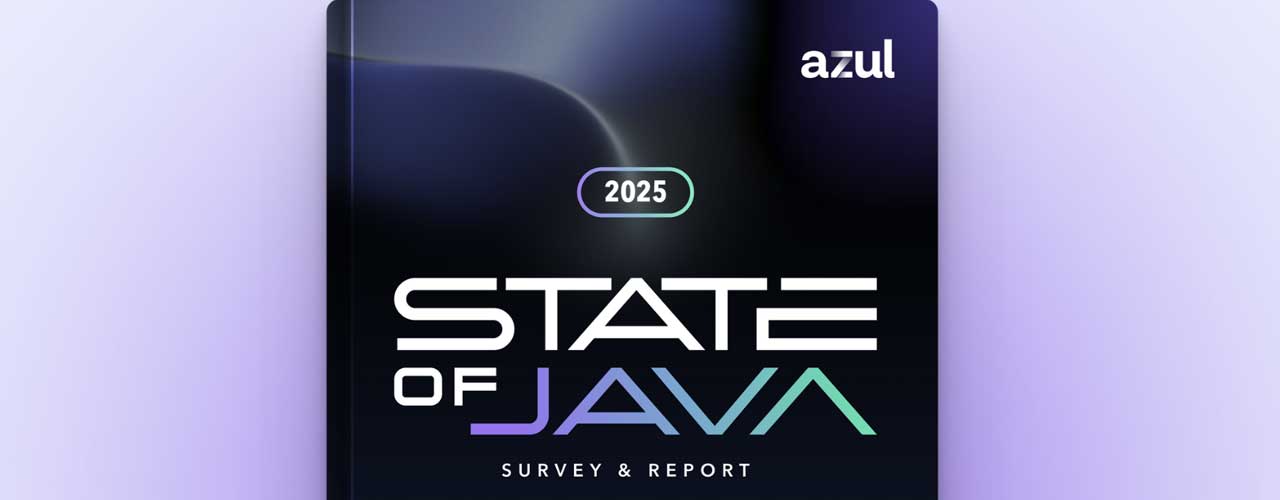
Azul’s 2025 State of Java Survey & Report covered the distributions and versions organizations use, the use of Java in the cloud, and the development of artificial intelligence. Three Java experts got together to discuss these findings and make some predictions about the future of Java.
Azul’s 2025 State of Java Survey & Report, a study of more than 2,000 Java professionals, gathered information about how organizations use Java. Participants answered questions about Java versions, the use of Java in the cloud, and the development of artificial intelligence. Freddy Guime, distinguished principal at Expedia Group, Daniel Hinojosa, owner of evolutionnext and Java Champion, and Azul Vice President of Developer Relations Pratik Patel met in February 2025 to discuss and analyze the results.
The interview transcripts below have been edited for brevity. The full interview video is available on azul.com.
Older and newer Java versions are used widely
Almost half of survey participants use the most recent Long Term Support Java version, Java 21, or the previous LTS, 17 (or both). Meanwhile, 19% use Java 6 or 7 (or both), which were released in 2011 and 2009 respectively.
Pratik: The thing that speaks volumes to me about that is just the kind of stability and the backward compatibility, and all the great things in the Java ecosystem or the Java virtual machine that you can have.
Daniel: It’s been 8 for a long time but I think Spring has kind of pulled people toward the future. And I think that’s a good thing as well. So yeah, I’m seeing a lot more JDK 17 now.
Pratik: Let me elaborate on that for our audience real quick. What Daniel is referring to is the Spring framework with Spring Boot. 3.2 requires at least Java 17 to run. So if you’re running spring 2.x, you can’t go to Spring 3.2 unless you move to Java 17+. Right? That’s what you’re referring to.
Freddy: Every enterprise will have a mix, but I think it’s really tilted to the later JDK versions. Where you see the pockets of the legacy are essentially systems that are very hard to change because they are very entrenched into like opera. You see a lot in the financial part where it’s hard to move this type of code base…. And these are usually isolated systems because … you don’t want to expose that to anything, right?
Java unused cloud compute capacity is acceptable
In the survey, 71% of Java development shops have more than 20% unused compute capacity in the cloud. The three experts agreed that this is an acceptable level.
Daniel: 20% is actually okay. Maybe we can do like 10%.
Freddy: When it grows big enough, I do think companies should consider getting somebody who specializes in that kind of optimization. There is a lot of literature that, like Netflix has, for example, been using predictive partners to preemptively autoscale.
Pratik: There wasn’t a process for this in the past. In the go-go days of the early 2020s, when we were all stuck at home and all the software tech stuff was going bonkers because everything was scaling up to be online, it expanded in cost. Go buy all the stuff you need or rent as many servers as you need. Get the biggest database you can get, etc, etc, right? Every other business software and computing is essentially a cyclic business. So we hit the peak a couple of maybe 2 or 3 years ago. And now we’re on that kind of coming back around to okay, maybe we spent too much money on all this cloud stuff. Do you guys have something called a FinOps organization within your company?
Freddy: “Once you start having a significant investment in cloud, it makes sense to have essentially a department that helps you manage that cost.
Artificial intelligence
In the survey, 50% of Java users use Java to develop AI functionality, more than any other programming language.
Daniel: I usually start off with, here’s my goal. Here’s what I need to do entirely. And it works really great for that.
Freddy: There are legal concerns for using ChatGPT as much as I want to use it. The moment that you paste code there, unless you’re covered by some kind of license, they essentially say we can just take whatever you have and use it to retrain our models, right?
Pratik: So hold on. So that’s in the other direction, right? Because a lot of people are worried about, if I use one of these AI code assistants and it generates code for me and I put it into my code base, has it gotten that snippet of code from something that’s like GPL or something? But you’re saying the other direction where if you place some of your proprietary company code into like a ChatGPT, it uses it to train their model in the future.
Freddy: I think it’s going to change what it means to be a software engineer. If you’re an engineer… you need to develop your knowledge and establish yourself not just necessarily as a coder, but more as a system designer of enterprise architect. Because those are going to be the things that that AI cannot do because those are required trade-offs that AI may not be able to see, and it requires an opinion that you are the one who is feeding it in.
Daniel: I tried to start last year and still doing it this year is bringing the junior programmers regardless. So you know, don’t replace them with AI. You need them, and the reason you need them is they know your business. A computer science knowledge goes really far.
But unfortunately, for a lot of young developers coming out of school, it’s not enough. You have to pair it with another domain, and that’s where it is. Shipping, travel, whatever. And you know, I think that’s going to be part of the reality, and a lot of that could be learned on the job. And that’s where junior developers come in. They learn your domain and they get good at it.
The other thing is data. Scientists love their Python, like the ones that actually do the ML stuff. They like their Jupyter Lab or Jupyter Notebooks and they’re familiar with that tool set. The best we can do is have an embedded model. In other words, the same pod where your Java application resides, or do what’s called a serving of your Machine Learning model, which is host, a restful endpoint, and put the inputs there. And we’re going to be waiting for things like the vector, API, and Java and the FFM, the foreign function memory model. And how to tie that in, and to see a little bit better. And so we’ll see hopefully a a good migration into actually doing ML in Java, using those.
Pratik: It will form function, memory API, which will allow Java developers to write libraries, to be able to do a lot of things that are possible with Python libraries… But the irony of this is that Python, like Torch and Numpy, and all those other things that are used to build out these AI models, the Python code is actually just more of a shim or a wrapper around a low-level C library anyway. People have had a head start in it, and they’ve been developing these libraries for years.
The interview video is available on azul.com. Watch the entire unedited interview now.
The 2025 State of Java Survey & Report is available on azul.com now as well. Read the full report today.





